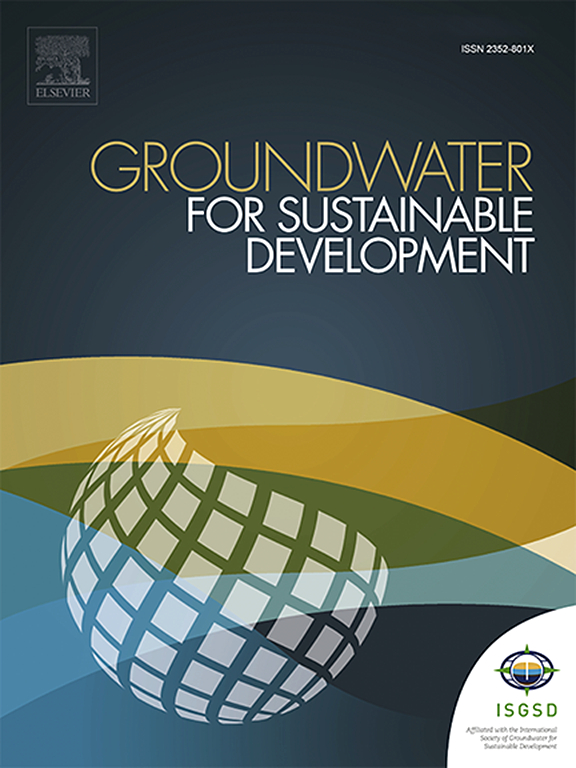尼泊尔加德满都谷地地下水重金属污染和水化学分析及其健康意义
IF 4.9
Q2 ENGINEERING, ENVIRONMENTAL
引用次数: 0
摘要
在加德满都谷地开展的研究对水质进行了评估,分析了 50 份水样的水化学参数和重金属含量,采用了严格的质量控制、Origin 软件和 ArcGIS 数据分析以及各种指数,包括水质指数 (WQI)、重金属污染指数 (HPI)、重金属评估指数 (HEI) 和环境水质指数 (EWQI),并通过慢性每日摄入量 (CDI) 和危险系数 (HQ) 分析了重金属暴露对人类健康的危害。Piper 图表明,大部分选择性属于 Ca2+-Mg2+-HCO3ˉ 成分,表示暂时硬度。重金属参数按照铁、锰、锌、砷、铬、镍、铅、铜、镉的顺序排列,除铁和锰外,平均值均低于《国家饮用水水质标准》。根据标准值和相对权重,水质指数将锰、NH4+、铁和铅归为高含量,而将铜和镉归为较低权重。WQI 值与其他指数呈高度显著的正相关,而所有样本的 HPI 值均超过 100,则表明饮用水不安全。此外,研究还表明,所有地点的重金属暴露量都超过了可接受的水平,存在非致癌健康风险,因此需要加强监管和执法,制定补救策略,并进行严格的健康风险评估,以改善所研究河谷和类似地区的水质和公众健康问题。本文章由计算机程序翻译,如有差异,请以英文原文为准。

Heavy metal pollution and hydrochemistry analysis of groundwater in Kathmandu Valley of Nepal and its health implications
The study conducted in Kathmandu Valley assessed water quality analyzing 50 water samples for hydrochemical parameters and heavy metals, employing rigorous quality control, data analysis with Origin software and ArcGIS, and various indices including Water Quality Index (WQI), Heavy Metals Pollution Index (HPI), Heavy Metal Evaluation Index (HEI), and Environmental Water Quality Index (EWQI), with human health risks from heavy metal exposure through Chronic Daily Intake (CDI) and Hazard Quotients (HQ). Piper diagram signifies, most of the selective falls under Ca2+-Mg2+-HCO3ˉ composition indicates the temporary hardness. The heavy metal parameters follow the sequences of Fe > Mn > Zn > As > Cr > Ni > Pb > Cu > Cd with the mean value below the National Drinking Water Quality Standards except for Fe and Mn, and substantially heterogeneous spatial distribution patterns with 60 % samples as high metal class. The WQI categorizes high levels of Mn, NH4+, Fe, and Pb, while assigning lower weights to Cu and Cd based on standard values and relative weights. The WQI value shows a high significant positive correlation with other indices, while the HPI values exceeding 100 in all samples indicate that the water is unsafe for drinking. Furthermore, the study depicts non-carcinogenic health risks from heavy metal exposure beyond acceptable levels across all sites, emphasizing the need for stronger regulation and enforcement with the development of remedial strategies and rigorous health risk assessment to improve the quality and public health concerns in the studied valley and in similar regions.
求助全文
通过发布文献求助,成功后即可免费获取论文全文。
去求助
来源期刊

Groundwater for Sustainable Development
Social Sciences-Geography, Planning and Development
CiteScore
11.50
自引率
10.20%
发文量
152
期刊介绍:
Groundwater for Sustainable Development is directed to different stakeholders and professionals, including government and non-governmental organizations, international funding agencies, universities, public water institutions, public health and other public/private sector professionals, and other relevant institutions. It is aimed at professionals, academics and students in the fields of disciplines such as: groundwater and its connection to surface hydrology and environment, soil sciences, engineering, ecology, microbiology, atmospheric sciences, analytical chemistry, hydro-engineering, water technology, environmental ethics, economics, public health, policy, as well as social sciences, legal disciplines, or any other area connected with water issues. The objectives of this journal are to facilitate: • The improvement of effective and sustainable management of water resources across the globe. • The improvement of human access to groundwater resources in adequate quantity and good quality. • The meeting of the increasing demand for drinking and irrigation water needed for food security to contribute to a social and economically sound human development. • The creation of a global inter- and multidisciplinary platform and forum to improve our understanding of groundwater resources and to advocate their effective and sustainable management and protection against contamination. • Interdisciplinary information exchange and to stimulate scientific research in the fields of groundwater related sciences and social and health sciences required to achieve the United Nations Millennium Development Goals for sustainable development.
 求助内容:
求助内容: 应助结果提醒方式:
应助结果提醒方式:


